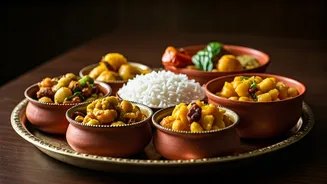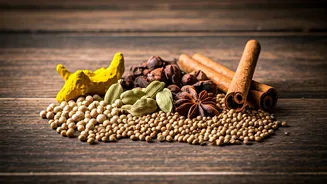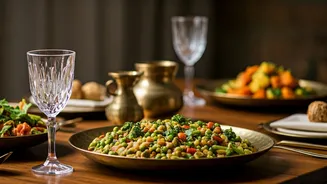Mindful Eating Practices
The first eating ritual centers on mindful consumption, a practice deeply ingrained in Indian culture. This involves paying close attention to the meal's
appearance, smell, and taste, essentially using all senses. Eating with awareness also encourages slowing down and appreciating each mouthful, which promotes better digestion. Furthermore, mindful eating means being fully present during the meal, free from distractions like television or mobile phones. This enables a deeper connection with the food, fostering a sense of gratitude for the nourishment provided. The practice encourages one to listen to the body's hunger and fullness cues, minimizing overeating and promoting a balanced diet. Practicing mindful eating not only enhances the enjoyment of food but also plays a crucial role in overall health and well-being.
Timing Your Meals
Next on the list is the importance of timing your meals appropriately, a fundamental aspect of Indian eating rituals. The ancient practices highlight the need for regular meal times, with particular emphasis on having a proper breakfast and dinner. Breakfast is often considered the most important meal, providing energy to kickstart the day. Dinner, on the other hand, should ideally be lighter and consumed a few hours before bedtime to aid digestion and sleep. The principle also stresses avoiding late-night snacking or overeating close to bedtime, promoting better sleep quality. Consistent meal timings help regulate the body's natural rhythms, supporting digestive health. This practice contributes to metabolic efficiency and ensures the body effectively utilizes the nutrients consumed.
The Art of Chewing
The art of chewing is another critical aspect, a practice that's often overlooked in modern, fast-paced lifestyles. The ritual emphasizes the importance of thorough chewing, promoting better digestion. The act of chewing breaks down food into smaller particles, easing the burden on the digestive system. Adequate chewing also stimulates the production of saliva, which contains enzymes that begin the digestion process. Eating at a slower pace due to thorough chewing gives the body time to register fullness, which curbs overeating. The ritual of chewing also ensures the body maximizes nutrient absorption from the food consumed, promoting overall health and well-being. This simple yet profound practice is a cornerstone of traditional Indian eating habits.
The Importance of Variety
In traditional Indian diets, the emphasis on variety is another key aspect. It involves consuming meals with a wide range of food groups, including grains, pulses, vegetables, fruits, and dairy products. This ensures a balanced intake of nutrients, vitamins, and minerals. Variety also promotes a well-rounded diet, preventing deficiencies and ensuring optimal bodily functions. Furthermore, including diverse foods supports a healthy gut microbiome, which is vital for digestion, immunity, and overall health. The ritual of eating a diverse diet also ensures the enjoyment of a wider range of flavors and textures, making each meal a satisfying experience. Embracing variety is not merely a practice but a celebration of culinary diversity, fundamental to Indian food culture.
Eating with Others
Finally, the practice of eating meals in the company of others is a cherished aspect. It strengthens bonds and fosters a sense of community. Shared meals are seen as opportunities for social connection, promoting mental well-being and emotional support. Eating with others often leads to a more relaxed and mindful dining experience, which, in turn, helps digestion. The communal meal setting encourages slower eating and promotes the appreciation of food. This ritual provides a break from the isolation of individual meals. It highlights the importance of social interaction in enhancing overall quality of life. The tradition of eating together is a testament to the value placed on human connection within the Indian cultural context.











